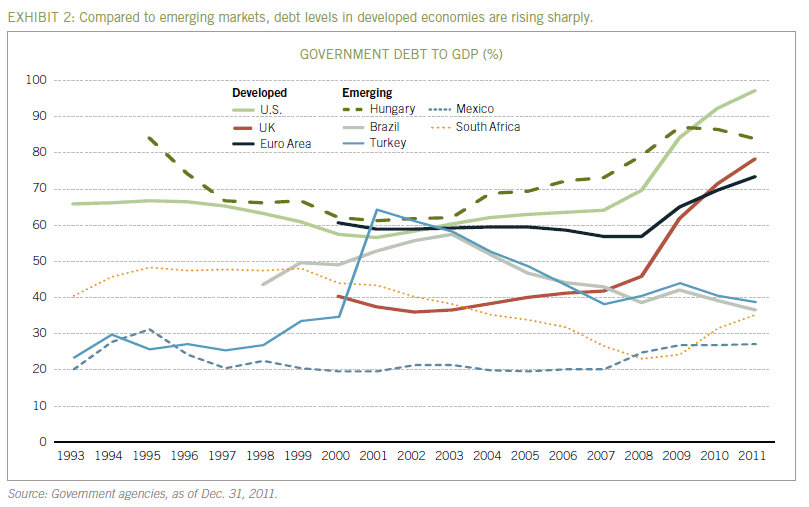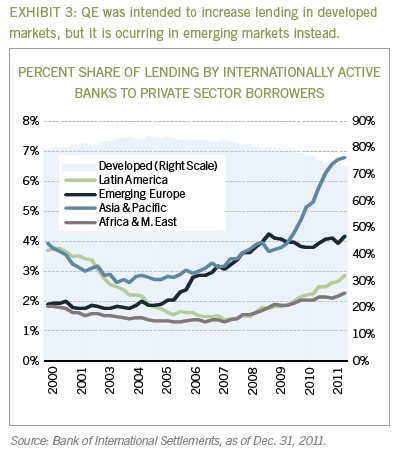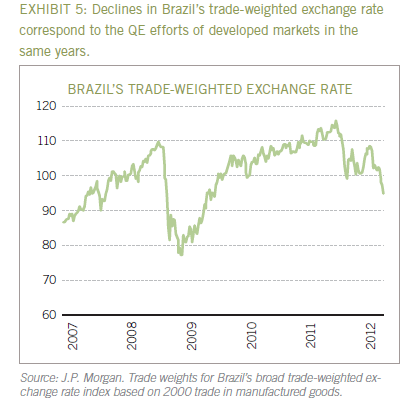Rubén Calderón
Portfolio Manager, Fidelity Asset Management, Global Asset Allocation
This article is part of Fidelity Asset Management’s ‘Leadership Series’ and appears here with the express permission of the author
The economic malaise in the aftermath of the global credit crisis has called for extraordinary monetary policy responses, especially in the form of quantitative easing (QE). While central banks have focused on the unique circumstances of their own nations, the collective magnitude of QE has had unintended consequences beyond the borders of their constituencies. This paper will discuss the consequences of QE outside of developed markets—where most of the QE has taken place—and its effects on emerging markets. Specifically, it will highlight the massive liquidity pouring into emerging markets, identify the primary source and reason for the excess liquidity, and provide specific examples of how QE has inadvertently disrupted emerging-market currencies, exports, inflation levels and more.
Key takeaways
- In recent years, central banks of developed markets have used quantitative easing (QE) in an attempt to stimulate their economies, increase bank lending, and encourage spending.
- To date, however, the greater availability of credit in developed markets has not been offset by demand, resulting in an abundance of excess liquidity.
- Much of this surplus capital has flowed into emerging markets, which has had adverse effects on their currency exchange rates, inflation levels, export competitiveness, and more.
- Nevertheless, we believe emerging markets continue to offer compelling investment opportunities. Investment-grade emerging market debt appears attractive in the near term, while equities may face more volatility.
A brief history of quantitative easing
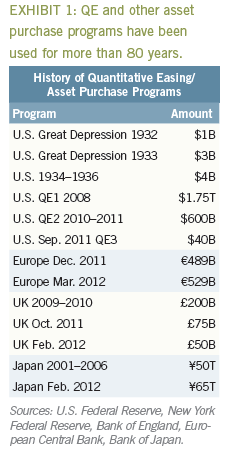 Quantitative easing is a government monetary policy occasionally used to increase the money supply by buying government securities or other securities from the market, thereby flooding financial institutions with capital in an effort to promote increased lending and liquidity. QE is the policy tool that central banks use when interest rates have neared or reached the zero bound and circumstances call for economic stimulus. Such a condition is known as a zero interest-rate policy (ZIRP) environment. QE and other asset purchase programs have come into play in modern economic history under exceptional circumstances (see Exhibit 1, left). In the early 1930s, the U.S. Federal Reserve implemented asset purchase programs to combat the Great Depression. However, QE was not yet an established weapon against economic stagnation, and these foundational efforts failed to achieve the desired effect. In fact, QE as we know it today would not be implemented until the current millennium.
Quantitative easing is a government monetary policy occasionally used to increase the money supply by buying government securities or other securities from the market, thereby flooding financial institutions with capital in an effort to promote increased lending and liquidity. QE is the policy tool that central banks use when interest rates have neared or reached the zero bound and circumstances call for economic stimulus. Such a condition is known as a zero interest-rate policy (ZIRP) environment. QE and other asset purchase programs have come into play in modern economic history under exceptional circumstances (see Exhibit 1, left). In the early 1930s, the U.S. Federal Reserve implemented asset purchase programs to combat the Great Depression. However, QE was not yet an established weapon against economic stagnation, and these foundational efforts failed to achieve the desired effect. In fact, QE as we know it today would not be implemented until the current millennium.
Japan is credited as being the first to implement modern quantitative easing. Its inaugural QE program in 2001—in response to the persistent economic slump following the Japanese stock and real estate market crashes in 1989—was the first of its kind in post-World War II financial history. But it wasn’t until the past few years that QE was implemented with such regularity and scale. And the collective magnitude of that liquidity—exacerbated by the globalization of financial infrastructure—has been a catalyst for the turbulence in emerging markets today.
The Great Recession and eurozone debt crises—drivers of unprecedented QE
The need for such aggressive monetary actions in recent years can be traced to the U.S. real estate bubble, which burst in 2007, and to the more-recent sovereign debt crisis in the eurozone. When the toxicity of subprime mortgage instruments came to light near the end of the past decade, the U.S. equity market suffered huge losses, financial institutions collapsed, and investor confidence plummeted. This series of events was swiftly replicated around the world, and the Great Recession was born.
To preserve the financial viability of their markets and jumpstart their flagging economies, developed-market central banks—first in the U.S. and then overseas—responded to the credit crisis with unprecedented levels of quantitative easing. Many of these banks were already overleveraged and/or saddling their balance sheets with additional debt in the form of bailouts. Exhibit 2 (below) shows the sharp increase in developed-market government debt since the Great Recession, compared to the much lower levels of debt in emerging markets. The importance of this distinction will be clarified later in this paper, but in short, it illustrates why emerging markets became a target for excess liquidity.
One major feature of the world economy that both preceded and followed the Great Recession is the globalization of the existing financial infrastructure. Globalization is defined as the development of an increasingly integrated global economy marked especially by free trade and the free flow of capital. This economic interdependence explains why both the past Great Recession and current eurozone crisis have had such reach. It also helps explain why ZIRP and QE have become the cause and effect for further monetary easing. It can also be said that the eurozone has implemented QE in the form of recent long-term refinancing operations (LTROs), which, like QE, increased the capital available for commercial banks to lend.
Bank lending flows—the primary source of excess liquidity
In theory and in practice, QE attempts to fire the economic cylinders by increasing lending and credit (e.g., liquidity). Liquidity discussed within this paper is in context of bank flows. Liquidity germane to the mutual fund industry (flows into/out of specific funds or asset classes, for example) are referred to as investment flows. Investors, mostly in the form of mutual funds and hedge funds, are often at the center of international financial crises. Invariably, they also bear the brunt, as has been the case in recent financial history—from the 1980s Latin America debt crisis to the recent Great Recession. This has led to the perception that investment flows play a destabilizing role in macroeconomic and financial systems. However, this view is untrue.1 The pre-existing condition preceding all these aforementioned crises has been excessive bank lending, which, at its simplest level, boils down to supply outstripping demand.
Why is excess liquidity flowing to emerging markets?
Despite its best intentions, the much-awaited thrust from QE remains elusive in developed markets, primarily because the higher availability of credit has not been met by a higher level of borrowing. Instead, data from the Bank of International Settlements (BIS) shows that the growth of credit and lending to private borrowers (i.e., non-government entities) is occurring in emerging markets (see Exhibit 3, left).
Emerging markets have been a popular target of excess capital for a number of reasons:
- Their overall ability to take on debt remains strong
- They have experienced minimal balance sheet impairment compared to developed markets
- Investment yields have been high relative to sovereign competitors
- They have relatively innocuous levels of pre-existing leverage
These strong lending patterns have been a multiquarter trend for the past few years. In fact, according to BIS, emerging-market lending had increased for 10 consecutive quarters through the end of 2011, while it continued to be lethargic in advanced economies where QE was expected to take root.
Specific effects and risks of QE on emerging markets
With the potential for European banks to rein in and repatriate liquidity amid risk aversion and fears of a euro collapse, it is easy to see why risk has morphed and embedded itself into emerging markets. More explicit consequences have already been felt, including:
- Higher inflation. Investment flows into emerging markets slowed in 2011, reflecting investors’ fears about inflation. According to the Institute of International Finance (IIF), net private capital flows to emerging markets were $910 billion in 2011, declining from $1.04 trillion in 2010. Although it has dipped slightly in emerging markets thus far in 2012, inflation remains a significant threat to emerging markets, particularly if food and commodity prices—which constitute a higher percentage of GDP in developing economies than advanced ones—continue to rise. Inflation in emerging markets, and whether policymakers are reactive or preemptive, is an important investment variable. So one should be aware that emerging-market monetary regimes are not created equal. As shown in Exhibit 4 below, the difference between policy rates and inflation rates among individual emerging-market countries can vary considerably.
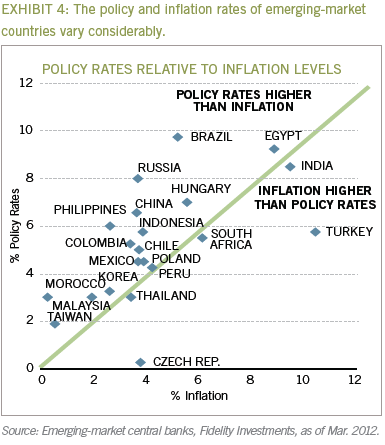
- Currency depreciation. The sharp fluctuation in Brazil’s effective exchange rate during 2008 and 2011 (see Exhibit 5) is just one example of the level of volatility induced into foreign exchange markets by quantitative easing. It also reflects the disruptive effect on trade and investment flows from such currency fluctuations. The interpretation of the effective exchange rate is that as the index increases, the purchasing power of Brazil’s currency—the real—grows higher. In other words, the real strengthens relative to the currencies of Brazil’s trading partners. But a lower index means that the currency depreciated, or was devalued, so that the country needs more of its own currency to pay for imports. This is what Brazil and other developing economies are facing today.
- The financialization of commodities. Emerging markets are one of the driving forces of commodities from both a supply and demand perspective. Thus, the effects of commodity price inflation on core inflation are more present and more sensitive in emerging markets than in advanced ones. One recent hallmark of global financial markets has been the increased correlation of asset classes, even among disparate ones. Nowhere is this anomaly more visible than the relationship between equity and commodity markets. Traditionally, these two asset classes have had a low degree of correlation. Yet recent evidence2 has corroborated that commodities and equities are beginning to move in lockstep. If this trend continues, it could detract from the diversification benefits of commodities. Also, to the extent that commodity pricing becomes detached from real supply and demand factors and becomes linked to financial factors, the closer it comes to the direct influence that monetary policy can have on financial markets. Thus, the entrance of QE onto the world stage has the power to affect core inflation in emerging markets through the financialization of commodities.
- Threats of retaliatory measures. In a world with heightened systemic risks elevated to a global scale, the consequences of QE should be a first-order concern in monetary policymaking. This is contrary to the current notion that central banks ought to focus on domestic variables and get their “houses in order.” This practice can affect foreign exchange in a way that may disrupt trade flows and prove counterproductive. Retaliation in the form of explicit trade barriers and the introduction of capital controls is a sure way to unchain trade frictions that would, in the end, leave the world worse off.
Rejecting the “house in order” view
Emerging-market leaders and other respectable figures in the world of political economy strongly reject the ‘’house in order” view, believing that monetary policy premised solely on domestic variables and outcomes overlooks the globality of our modern-day financial world and is, in the end, self-defeating.
One such critic is Brazilian President Dilma Rousseff, who has publicly voiced concerns about the destabilizing foreign exchange distortions caused by the massive liquidity injections from QE. In April 2012, President Rousseff criticized Western monetary policy, which she said was damaging Latin American industry. Rousseff called for Latin America to defend itself against the “tsunami of money” flowing into emerging markets as a result of expansionary monetary actions in developed markets. This money has led, she said, to rocketing levels of foreign investment into Latin America, resulting in an overvaluation of the region’s currencies and subsequently damaging exports.3
Lorenzo Bini Smaghi, former member of the Executive Board of the European Central Bank, is another proponent of more transparent international policy cooperation:
“A key message for all of us from the crisis is that keeping an economy in order, keeping one’s own house in order, so to speak, does not necessarily insulate it from external shocks. Moreover, an excessive focus on the domestic economy may actually exacerbate global economic and financial imbalances, ultimately making future global crises more likely and more severe. The key challenge faced by global policymakers is to make the system safer and avert future crises. No country is immune to them. Strengthening international cooperation in the global economic and financial sphere is crucial.”4
Investment implications
Emerging markets continue to offer compelling short- and longterm investment opportunities. Still, it is important to recognize the many variables that could impact the relative attractiveness of the asset class. The excess liquidity coming from the central banks of the developed world may potentially undercut the growth potential for emerging economies and distort how the currency markets reflect a country’s fundamental macro standing.
In light of the recent inflation scare and destabilizing liquidity flows, investment-grade emerging-market debt appears attractive in the near term, whereas equities may face more challenges. In short, the main drivers will be competitiveness and liquidity. A process based on fundamental research may be best positioned to identify those countries and individual securities that are most likely to be receptive to flows and remain competitive. Importantly, insights gathered from fundamental research can help manage the risks associated with emerging markets.
At the end of the day, no one can predict when the unintended consequences of QE will lessen. But informed decision-making and a disciplined investment approach that acknowledges these issues can help investors navigate the opportunities and risks presented by quantitative easing.
Rubén Calderón
Portfolio Manager
Ruben Calderon is a portfolio manager for Fidelity Asset Management, Global Asset Allocation. Fidelity Investments is a leading provider of investment management, retirement planning, portfolio guidance, brokerage, benefits outsourcing, and other financial products and services to more than 20 million individuals, institutions and financial intermediaries.
Endnotes
- Foreign Affairs, “The Color of Hot Money,” Martin Baily, Diana Farrell, and Susana Lund. March/April 2000.
- United Nations Conference on Trade and Development; Development and Globalization 2012, “Financial Liberalization and the Financialization of Commodity Markets.”
- The Rio Times, Apr. 12, 2012.
- Speech by Lorenzo Bini Smaghi at the 21st Century Forum 2010, Beijing, China, Sep. 7, 2010.
The information presented above reflects the opinions of Portfolio Manager Rubén Calderón as of June 1, 2012. These opinions do not necessarily represent the views of Fidelity or any other person in the Fidelity organization, and are subject to change at any time based on market or other conditions. Fidelity disclaims any responsibility to update such views. These views may not be relied on as investment advice and, because investment decisions for a Fidelity fund are based on numerous factors, may not be relied on as an indication of trading intent on behalf of any Fidelity fund.
Past performance is no guarantee of future results.
Indices are unmanaged and you cannot invest directly in an index.
Diversification/asset allocation does not ensure a profit or guarantee against loss.
Stock markets, especially foreign markets, are volatile and can decline significantly in response to adverse issuer, political, regulatory, market, or economic developments.
Foreign markets can be more volatile than U.S. markets due to increased risks of adverse issuer, political, market or economic developments, all of which are magnified in emerging markets. These risks are particularly significant for funds that focus on a single country or region.
In general the bond market is volatile, and fixed-income securities carry interest-rate risk. (As interest rates rise, bond prices usually fall, and vice versa. This effect is usually more pronounced for longer-term securities.) Fixed-income securities also carry inflation risk, liquidity risk, call risk, and credit and default risks for both issuers and counterparties. Any fixed income security sold or redeemed prior to maturity may be subject to loss.
Unlike individual bonds, most bond funds do not have a maturity date, so avoiding losses caused by price volatility by holding them until maturity is not possible.
The commodities industry can be significantly affected by commodity prices, world events, import controls, worldwide competition, government regulations, and economic conditions.
For investment professional or institutional investor use only. Not for distribution to the public in any form. Fidelity Capital Markets is a division of National Financial Services LLC, Member NYSE, SIPC. Fidelity Family Office Services is a division of Fidelity Brokerage Services LLC. Clearing, custody, or other brokerage services may be provided by National Financial Services LLC or Fidelity Brokerage Services LLC, both Members NYSE, SIPC.
Products and services provided through Fidelity Financial Advisor Solutions (FFAS) to investment professionals, plan sponsors, and institutional investors by Fidelity Investments Institutional Services Company, Inc., 100 Salem Street, Smithfield, RI 02917 614167.2.0 © 2012 FMR LLC. All rights reserved.
